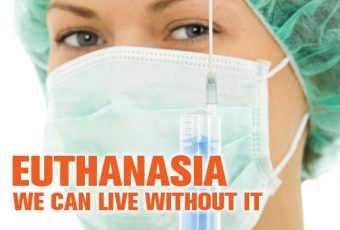
The following article was written by Dr Kevin Fitzpatrick and published on November 27 by CNN under the title:Euthanasia: We can live without it.
Editor's note: Dr. Kevin Fitzpatrick is director of the Euthanasia Prevention Coalition Europe, a group dedicated to opposing the legalization of euthanasia and promoting palliative care.
(CNN)-- Disabled people, elderly people, adults made vulnerable by terminal and other illnesses, and now children are being told that their lives are not worth living.
This view was forcefully expressed by Professor Etienne Vermeersch in a recent public debate on euthanasia in Brussels. One of the authors of Belgium's controversial euthanasia law, Vermeersch said it had been specifically designed to include disabled people.
For Vermeersch it seemed obvious that "a man with no arms or legs" would want to die.
Without conscience or insight into the discrimination of choosing only disabled people as examples, he shouted at a member of the audience "Just wait until you are paralysed." A paraplegic wheelchair-user for forty years, I was sitting directly in front of him, and had spoken before the debate.
His chilling and very final solution to suffering is to remove the sufferer. His zealous delivery caused a frisson in the room amongst most (though sadly not all) of the audience. With its clear echoes, this discourse from a government adviser was shocking.
Earlier in the same debate, Alex Schadenberg of the Euthanasia Prevention Coalition had pointed out that the law in Belgium is just not safe:
Dr. Jan Bernheim, a leading promoter of euthanasia, admitted that there are problems with Belgium's euthanasia law. But despite its "imperfections" he still believes it should be extended to children.
Bernheim argued euthanasia was necessary to remove suffering: yet pain is hardly ever the reason for seeking euthanasia. In fact, any palliative care specialist will say no-one should ever be in intolerable pain.
Bernheim claims Dr. Wim Distelmans as his protege: Distelmans recently ended the life of Nancy/Nathan Verhelst, in front of TV cameras. After a series of botched sex-change operations, in the absence of other support,Verhelst sought refuge in death by euthanasia.
The Belgian commission to regulate the practice of euthanasia has never referred a case of euthanasia to prosecutors (and remember only half of those are reported). It is co-chaired by Distelmans. It is fundamentally unsafe that the most high-profile doctor in Belgium to carry out euthanasia is also the regulator.
Distelmans also carried out the euthanasia of Mark and Eddy Verbessem, 45-year-old identical twins, who were deaf and decided they wanted to die after their eyesight began to fail.
Anorexic Ann G. also opted to have her life ended after being sexually abused by the Belgian psychiatrist who was supposed to be treating her for her life-threatening condition.
The core of good clinical governance is patient safety but under Belgium's euthanasia laws that is sacrificed in the name of individual choice. Verhelst, the Verbessems and Ann G. -- bereft of support -- felt they had no choice but death.
The European Social Rights Committee has condemned Belgium for violation of the European Social Charter because of its lack of social care. It is little wonder that disabled Belgian people fall into terminal despair, but that does not validate euthanasia becoming a "treatment" for depression as it has in Belgium.
Killing someone by lethal injection is ot an act of medicine: it comes when medicine apparently has nothing left to offer.
With a 500% increase in euthanasia in Belgium in ten years, it is crystal clear that the law in Belgium nis not safe; we cannot stand by as they try to extend that law to children.
The opposite view: Pray you never need euthanasia, but be glad of option
Interactive: Euthanasia and the right to die around the world
The opinions in this commentary are solely those of Dr. Kevin Fitzpatrick.
Published: 27th November 2013